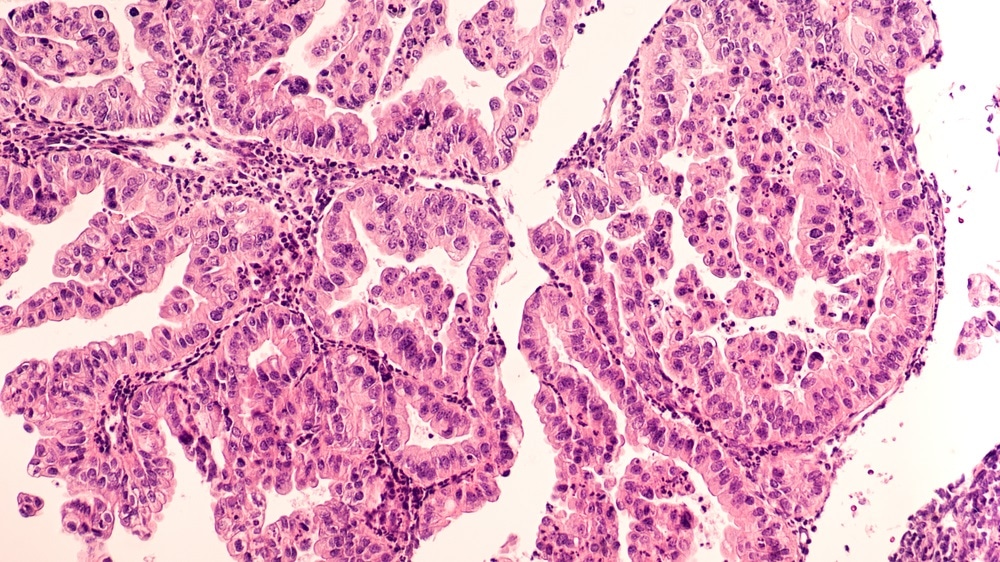Researchers at the University of Colorado Anschutz Medical Campus have made an important discovery about the behavior of ovarian cancer cells that could lead to a new treatment approach.
 Image Credits: David A. Litman / Shutterstock.com
Image Credits: David A. Litman / Shutterstock.com
Benjamin Bitler and colleagues from the CU Cancer Center say the new approach may induce a stronger anti-tumor response and lead to improved patient outcomes among patients with chemo-resistant disease.
How does ovarian cancer spread?
The majority of ovarian cancers originate in the fallopian tubes. Cancer cells then break away from this primary tumor and circulate in fluid until they reach new sites where they establish disease.
“Epithelial-derived high-grade serous ovarian cancer (HGSOC) is the deadliest gynecologic malignancy,” say Bitler and team. “Roughly 80% of patients are diagnosed with late-stage disease, which is defined by wide-spread cancer dissemination throughout the pelvic and peritoneal cavities.”
However, it is difficult for cancer cells to survive once they have detached from the primary tumor: “HGSOC dissemination is dependent on tumor cells acquiring the ability to resist anoikis (apoptosis triggered by cell detachment),” the researchers explain.
Researchers who have investigated how the cancer cells might do this have noticed that they tend to collect in tissues with a high fat content, suggesting that they use fat in some way to survive when leaving their site of origin.
What have Bitler and team discovered?
Now, Bitler and colleagues have investigated this possibility at the molecular level and shown that once ovarian cancer cells have detached from the primary site of disease, they turn to fats as a source of energy.
"When they break off, they metabolically shift to use fats more - it allows these cells to survive and then they seek out or are able to colonize fatty tissue,” explains Bitler.
The researchers also demonstrated how the cells achieve this switch. It seemed that an enzyme called CPT1A (carnitine palmitoyltransferase 1A) controls the amount of fat the cells can use and that disrupting their access to this enzyme limits the energy resource that fuels their survival.
“It looked like CPT1A was the rate-limiting step in their ability to do this," says Bitler.
An element of luck
Fortunately, Bitler just happened to be in the ideal place for further investigating the role CPT1A plays in the spread of ovarian cancer. A world-leading expert on the enzyme, Isabel Schlaepfer, happened to be based on the same campus as Bitler. Using funding she had received from the American Cancer Society, Schlaepfer had already been researching the role that CPT1A might play in prostate cancer.
"With Isabel's lab, we were able to demonstrate that, yes, the cells become more dependent on fatty acids to survive the attachment-free environment,” says Bitler. “For example, we showed that by adding fatty acids to a model of ovarian cancer cells in suspension, we could prevent these cells from dying.”
The effects of knocking down CPT1A
As reported in the journal Molecular Cancer Research, the team also found that knocking down CPT1A in the tumor cells stopped them from disseminating in cell-culture studies and delayed their spread in mouse models of human ovarian cancer.
It didn't completely abolish ovarian cancer cells' capacity to go to fat-rich sites, but it reduced it pretty dramatically."
Benjamin Bitler, CU Cancer Center
Could the approach be brought to the clinic?
As well as being able to work with Schlaepfer on the role CPT1A plays in the spread of ovarian cancer, Bitler has now teamed up with another colleague based at the campus, Brad Corr, to see whether this approach could be brought to the clinic to help patients.
"There's a drug called etomoxir that inhibits CPT1A and has been tested as a preventative for congestive heart failure," Bitler explains.
Trials investigating etomoxir for the prevention of congestive heart failure have found that the risk of side-effects outweighed the therapeutic benefits. However, Bitler thinks that in the cancer setting, the risks associated with etomoxir therapy would be far fewer than those associated with the use of current therapies.
"We are working with Brad [Corr] to move forward with this,” he says. However, “the question is where exactly to put etomoxir with respect to patient treatment."
A potential new approach to treating chemo-resistant cancer
Bitler explains that one major challenge faced when treating ovarian cancer is its ability to resist chemo: "The cells we've been studying resist cell death because they need to disseminate. Avoiding cell death is at the heart of chemoresistance as well," he says. "Our hope is that we could use etomoxir to treat chemo-resistant disease.”
First author of the study, Brandon Sawyer, also received American Cancer Society funding that helped to develop the study, which has led to further grants being submitted to the National Institutes of Health in the hope that this promising new approach might be taken from the laboratory into the clinic.
Sources:
Experimental medication to prevent heart disease may treat chemo-resistant ovarian cancer. EurekALert! 2020. Available at: https://www.eurekalert.org/pub_releases/2020-03/uoca-emt032620.php
Experimental medication to prevent heart disease may treat chemo-resistant ovarian cancer. Colorado Cancer Blogs 2020. Gareth Sundem. Available at: https://coloradocancerblogs.org/experimental-ovarian-cancer-treatment/
Journal reference:
Bitler B, et al. Targeting fatty acid oxidation to promote anoikis and inhibit ovarian cancer progression. Molecular Cancer Research 2020. DOI: 10.1158/1541-7786.MCR-19-1057